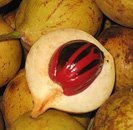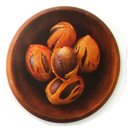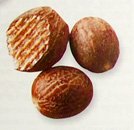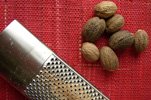Nutmeg Nutrition facts
Pleasantly aromatic, nutmeg is actually a seed (kernel) of the fruit from the Myristica fragrans tree. It is one of the highly prized spices known since antiquity for its aromatic, aphrodisiac, and curative properties.
Nutmegs are evergreen trees, native to the rainforest of Indonesian Moluccas Island, also known as the Spice Islands.
Botanically, the plant belongs to Myristicaceae family of medium to large trees. Its scientific name is: Myristica fragrans. Besides M. fragrans, several other species of Myristica grown all over the tropical regions including M. argentea, M. malabarica (Indian), and M. fatua. Although they are similar in appearance to M. fragrans, they, however, have a less intense flavor and aroma and command less price.

|

|
| Raw nutmeg fruit. Note for central seed and "lacy" mace. (Photo by-giselleai) | Note for golden-orange color "mace" enveloping around the dried whole nutmegs. Photo courtesy: "Cooking with herbs and spices" book. |
M. fragrans is a large evergreen tree that thrives well in tropical climates. A fully-grown tree may reach about 50-60 feet in height, and is the source of nutmeg, and mace, the two invaluable spices.
The nutmeg fruit, indeed, is a drupe about the size of an apricot, which upon ripening splits up to reveal a single, centrally situated oval-shaped, hard kernel, that is popular as "nutmeg spice." This seed (kernel) is closely enwrapped by crimson-red, lacy, or thread-like arils known as "mace." Both spices feature a similar warm, sweet aromatic flavor.
Processing
Nutmeg tree yields up to three times in a season. After the harvest, its outer coat or husk is removed and discarded. Just underneath the tough husk is the crimson red color aril, known as "mace," which firmly envelops the nutmeg kernel. Mace is gently peeled off from the nutmeg, flattened into strips, dried, and sold either as a whole (blades) or finely ground powder. Nutmeg kernel is then dried under the sun for several days to weeks.
At the large commercial setups, this process is accomplished rather more rapidly over a hot dryer machine until the whole nutmeg rattles inside the shell.
Its shell is then cut open and a single, shriveled nutmeg kernel is then taken out. Finally, nuts dipped in lime water in order to prevent insect infestation and seed germination, dried, packed, and dispatched to markets.
Health benefits of Nutmeg
Nutmeg and mace spice contain many plant-derived chemical compounds that are known to have been antioxidant, disease-preventing, and health-promoting properties.
The spicy nut contains fixed oil trimyristin and many essential volatile oils such as which give a sweet aromatic flavor to nutmegs such as myristicin, elemicin, eugenol and safrole. The other volatile oils are pinene, camphene, di pentene, cineole, linalool, sabinene, safrole, terpineol.
The active principles in nutmeg have many therapeutic applications in many traditional medicines as anti-fungal, anti-depressant, aphrodisiac, digestive, and carminative functions.
This spice is a good source of minerals like copper, potassium, calcium, manganese, iron, zinc, and magnesium. Potassium is an important component of cells and body fluids that helps control heart rate and blood pressure. The human body uses manganese and copper as co-factors for the antioxidant enzyme, superoxide dismutase. Iron is essential for red blood cell production and as a co-factor for cytochrome oxidase enzymes.
It is also rich in many vital B-complex vitamins, including vitamin-C, folic acid, riboflavin, niacin, vitamin-A and many flavonoids anti-oxidants like beta-carotene and cryptoxanthin that are essential for optimum health.
| Principle | Nutrient Value | Percent of RDA |
|---|---|---|
| Energy | 525 Kcal | 26 |
| Carbohydrates | 49.29 g | 38% |
| Protein | 5.84 g | 10% |
| Total Fat | 36.31 g | 180% |
| Cholesterol | 0 mg | 0% |
| Dietary Fiber | 20.8 g | 55% |
| Vitamins | ||
| Folates | 76 µg | 19% |
| Niacin | 1.299 mg | 8% |
| Pyridoxine | 0.160 mg | 12% |
| Riboflavin | 0.057 mg | 4% |
| Thiamin | 0.346 mg | 29% |
| Vitamin-A | 102 IU | 3.5% |
| Vitamin C | 3 mg | 5% |
| Electrolytes | ||
| Sodium | 16 mg | 1% |
| Potassium | 350 mg | 7.5% |
| Minerals | ||
| Calcium | 184 mg | 18% |
| Copper | 1.027 mg | 114% |
| Iron | 3.04 mg | 38% |
| Magnesium | 183 mg | 46% |
| Manganese | 2.900 mg | 126% |
| Phosphorus | 213 mg | 30% |
| Zinc | 2.15 mg | 20% |
| Phyto-nutrients | ||
| Carotene-ß | 16 µg | -- |
| Crypto-xanthin-ß | 90 µg | -- |
| Lutein-zeaxanthin | 0 µg | -- |
Medicinal uses
Since ancient times, nutmeg and its oil have been used in Chinese and Indian traditional medicines for illnesses related to the nervous and digestive systems. The compounds in this spice such as myristicin and elemicin have been soothing as well as stimulant properties on the brain.
Nutmeg oil contains eugenol, which has been used in dentistry for toothache relief.
The oil is also used as a local massage to reduce muscular pain and rheumatic pain of joints.
Freshly prepared decoction with honey has been used to relieve nausea, gastritis, and indigestion ailments.
Selection and storage
 |
| Nutmeg spice-grated section. Photo: "Cooking with herbs and spices" book. |
In the stores, one can get the nutmeg kernel as well as its fine powder. Try to buy the whole kernel instead of its powder, since oftentimes, it may be adulterated with other inferior quality nutmeg varieties. Choose a well-sealed pack from authentic brands from a reputable selling company that mentions its package and expiry dates.
Once at home, store whole nuts as well as a ground powder inside an airtight container and place cold, dark, and dry place, where it can stay for several months.
Culinary uses
Both nutmeg, as well as "mace", is used in cooking. Mace has a delicate flavor, and gives saffron-like color to the food items. Normally, a whole kernel is preferred over its powder since it possesses higher essential oils, which thus gives a rich flavor and freshness to recipes. In general, completely dried kernels are either grated or milled just before being added to cooking at the final stages.

|
| Nutmegs with a grater. (Photo courtesy by-kochtopf) |
Here are some serving tips:
Nutmeg and mace are being employed in sauces, soups, and confectionery.
Aromatic mace spice is especially used as a colorant and flavoring agent in sweets, pies, cakes, donuts, etc.
It is also being used as one of the common ingredients in curry powder to marinate meat and vegetable dishes in many Asian countries.
Safety profile
Consumption of nutmeg in large doses may cause lack of concentration, sweating, palpitations, body pain, and in severe cases, hallucination and delirium.
In very small doses, it may be used safely in pregnancy and lactation.
(Medical disclaimer: The information and reference guides on this website are intended solely for the general information of the reader. It is not to be used to diagnose health problems or for treatment purposes. It is not a substitute for medical care provided by a licensed and qualified health professional. Please consult your health care provider for any advice on medications.)
≻≻-Also read on Mace spice nutrition facts
≻≻-Back to Spices from Nutmeg. Visit here for an impressive list of healthy spices with complete illustrations of their nutrition facts and health benefits.
≻≻-Back to Home page.
Further reading:
Cooking with herbs and spices- by Andi Clevely- page 310-311.